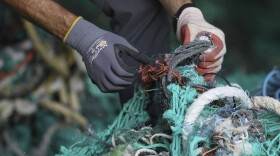All Hawaii airports that receive transpacific flights are now operating thermal cameras to screen out of state arrivals for symptoms of COVID-19.
Around 2,000 air travelers per day have been arriving in Hawaii in recent weeks. That represents a decline of more than 90% compared to the same period last year, when roughly 35,000 people flew to Hawaii every day.
Now the concourses of Honolulu’s Daniel K. Inouye International Airport are largely empty. Travelers who are still coming, both visitors and returning residents, are now subject to a body temperature screening by special thermal cameras. It’s part of the state’s effort to prevent passengers infected with COVID-19 from bringing the virus to Hawaii.
The system was paid for with funds provided to Hawaii under the federal CARES Act. Upon landing, passengers onboard a transpacific flight will deplane as usual. But now, before they can pick up their baggage or find a bathroom, a thermal camera will scan their heat signature to see if they are running a fever.
National Guardsmen monitor the camera feed in real time from a nearby tablet. The system will note anyone with a temperature greater than 100.4 degrees. If that happens, the traveler will be flagged for an additional health evaluation, according to Tim Sakahara, state Department of Transportation spokesman. The secondary screening will include another fever check and the offer of an actual COVID-19 test.
The state signed a 10-year contract with Japanese tech giant NEC Corporation to install and maintain cameras at five airports statewide, including Honolulu, Lihue, Kahului, Kailua-Kona, and Hilo. Those five facilities are the only commercial aiports in Hawaii that receive out of state flights.
Real passengers deplaning from a flight into HNL, going through the airport’s new thermal screening system. pic.twitter.com/IYskuvsojZ
— Ryan Finnerty (@rfinnerty1) August 6, 2020
Previously, members of the Hawaii National Guard were conducting fever checks using handheld thermometers. NEC Program Manager Bill Carleton said this type of camera system is much more efficient than scanning passengers by hand.
“Instead of taking half an hour or 45 minutes to offload 200 passengers on a flight, now they’re doing it inside of 10 or 12 minutes,” Carleton said.
NEC and the Department of Transportation demonstrated the system for members of the media during the arrival of a full flight from San Francisco into Honolulu. Masked passengers were able to exit via the jetway at normal speed. The cameras, positioned outside the jetway, were able to log the temperature of each arriving traveler.
The system allow screeners to as much as possible avoid close contact with travelers. National Guard soldiers were still present to check passengers who might not register, like small children or people in wheelchairs.
On this flight, no one presented a fever greater than 100.4 Fahrenheit. It is now widely known that not all COVID patients will display a fever, even if they show other symptoms, which may make it seem like temperature is not an effective screening tool.
But according to Tim Brown, an epidemic and infectious disease expert at the East-West Center, these types of symptom checks can produce a measurable impact. Citing a study from Taiwan, he said thermal screening at airports can capture as many as one-third of COVID-positive flyers.

“Airport screening for temperature and symptoms picked up about 32.7 percent of those cases, so one-third basically,” Brown said.
In the Taiwan study, all arriving passengers were tested and quarantined, in addition to getting a temperature check.Browns says the results are even better if thermal screening is paired with mandatory preflight testing for the virus. Using what he calls a layered system of protection, we could identify as many as 90 percent of infected individuals.
However, the idea is not without controversy. While phase one of the project only includes thermal screening, phase two will incorporate facial recognition cameras. When the thermal camera detects a fever, a facial recognition camera will instantly snap a photo of the fevered passenger’s face. The intent is to help screeners ensure they stop the right people.
The inclusion of the controversial face scanning technology has civil rights watchdogs on alert, including Matello Caballero with the ACLU of Hawaii.
“We have concerns about the constitutionality about the technology, particularly in Hawaii where there is a constitutional right to privacy specifically recognized in the Hawaii Constitution,” Caballero said.
Earlier this year, Caballero sent a letter to Hawaii Gov. David Ige outlining those concerns, but has not yet taken further action.
In response to the concerns, Sakahara said the state is taking precautions to protect flyers’ privacy. He said only passengers running a fever will have their photo taken and those photos will be quickly deleted.
“It’s only going to be kept on file for 30 minutes and then it will be purged and deleted,” Sakahara said.
“The picture itself will not identify that person. It won’t know their name, won’t know their address, certainly not something like their Social Security number. None of that will be known.”
The ultimate goal of the facial capture is to allow screeners to be even further removed from the potentially sick passenger. Theoretically, the system would detect a traveler with a fever, capture their photo, and then send it to a designated response team elsewhere in the terminal.
But such a system is still months away from being ready. For now, the system is only checking temperatures, with the facial recognition component expected to be ready in December.



